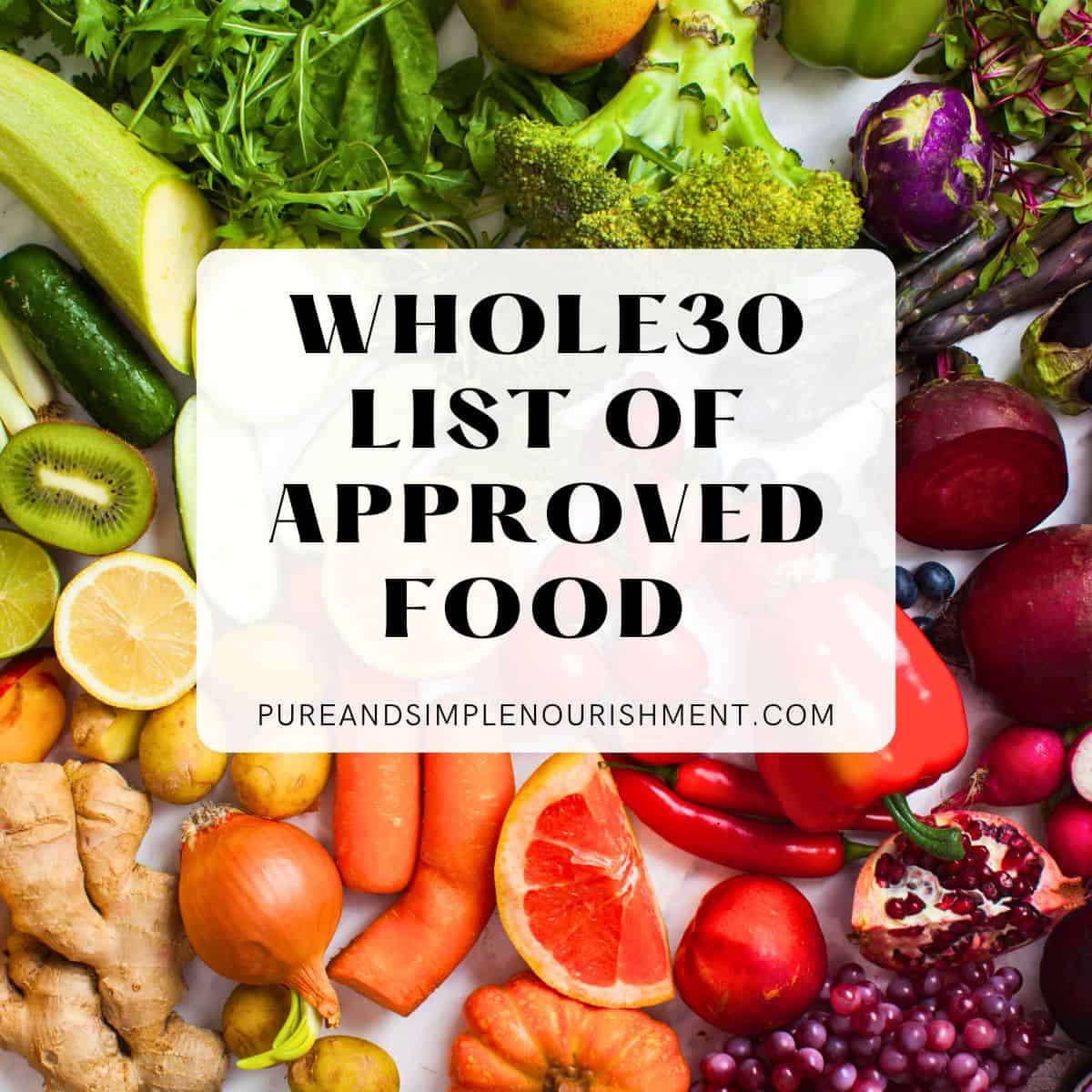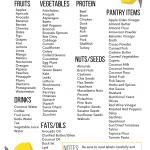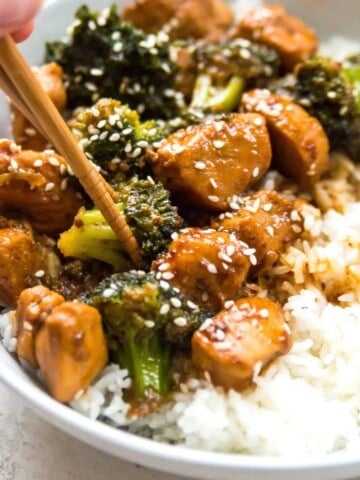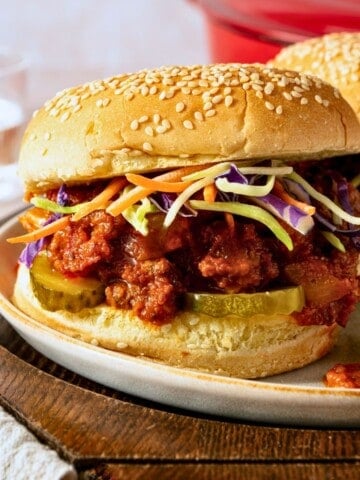If you are following the Whole30 program you will want this Whole30 list of approved food to make your experience so much easier. I've also included a printable shopping list to help you remember what foods you can eat and what foods aren't allowed on the Whole30 diet.

Disclaimer: some of the links in this post are affiliate links where I make a small percentage if you purchase the product through that link. This does not cost you anything extra and helps me keep this website running.
Table of Contents
What is the Whole30 diet?
The Whole30 diet is an elimination diet that removes dairy, sugar, grains, soy, legumes, alcohol, and ultra processed foods from your diet.
The diet is designed to be a 30 day re-set where you focus on eating real food for 30 days, and then you re-introduce foods slowly to help determine which foods you might be sensitive to.
The Whole30 program is proposed to help with weight loss, gut issues, diabetes, sleep, blood pressure, acne and other health issues. There are many anecdotal reports of people seeing improvements in their health on the program, but just note that to date, there have been no studies examining the effects of the diet directly.
The Whole30 diet may sound restrictive, but it doesn’t have to be! You can still enjoy so much amazing, delicious foods while doing a Whole30 diet. However, when first starting a Whole30 diet it can be confusing to know which foods are Whole30 compliant or not. That's why I made this post! I want to make your Whole30 experience as easy as possible. I've also included a free Whole30 shopping list that you can download and print to take with you to the grocery store.
Foods allowed on the Whole30 diet:
Vegetables:
All vegetables, including starchy vegetables like potatoes and sweet potatoes are allowed on the Whole30 diet. I've included a more complete list of vegetables in my shopping guide below so be sure to check that out.
Vegetables are a great source of many vitamins, minerals and fiber and are also part of a healthy diet. But just be sure to stick with fresh vegetables or frozen vegetables which will have the highest nutrient density. Certain brands of canned vegetables would also be Whole30 compliant, just be sure to read the labels carefully and avoid any canned vegetables with added sugars, natural and artificial flavours or other refined or processed ingredient.
Here is a list of vegetables that you are allowed to eat on the Whole30: artichokes, arugula, asparagus, beets, bell peppers, broccoli, Brussels sprouts, bok chow, cabbage, carrots, cauliflower, celery, collard greens, cucumber, eggplant, fennel, green beans, kale, leeks, lettuce, mushrooms, onions, parsnips, potatoes, spinach, squash, Swiss chard, tomatoes and zucchini.
Fruits:
All fruits are allowed on the Whole30 program. Unlike a keto diet or low carb diet the Whole30 program doesn't want you to count carbs or macros so that is why all types of fruit can be eaten.
Fruits are a great source of vitamins, minerals, antioxidants and fiber and can be a great way to satisfy any sugar cravings when doing a Whole30 diet.
Like vegetables, sticking with fresh fruit or frozen fruit is your best bet. Some canned fruits have added sugars and syrups which aren't allowed on the Whole30 program.
Here are some of the fruits you can eat when doing a Whole30: apples, apricots, avocado, bananas, berries, cherries, dates, figs, grapes, kiwi, lemons, limes, mango, melons, nectarines, oranges, papaya, peaches, pineapple, plums, plantains, pomegranate, watermelon.
Meat, fish and eggs:
Any unprocessed types of meat and fish are allowed on the Whole30 diet. Eggs are also allowed. You can even eat bacon while on the Whole30 program, as long as you find a brand that's sugar free.
Here are some of the proteins you can eat on the Whole30 program: beef, bison, chicken, duck, eggs, fish, lamb, pork, shellfish and turkey.
Nuts and seeds:
All nuts and seeds, except for peanuts (which are a legume, not a nut) are allowed on the Whole30 program. Just be sure you are getting nuts and seeds that don't have any added sugars and are not roasted in crop oils such as canola oil.
The nuts and seeds you can eat include: almonds, Brazil nuts, cashews, chia seed, flax seeds, hazelnuts, macadamia nuts, pecans, pistachios, pine nuts, pumpkin seeds, sesame seeds, sunflower seeds and walnuts.
Oils and fats:
Many different fats and oils are allowed on the Whole30 program. These include avocado oil, ghee, coconut oil, duck fat, lard, olive oil, sesame oil and tallow.
Note that crop oils like canola oil are not allowed and oils or fats that contain dairy such as butter are also not allowed.
Condiments and spices:
Condiments made with Whole30 compliant ingredients are allowed and some brands including Primal Kitchen have entire collections of condiments and sauces which are Whole30 approved.
All spices (as long as they don't have any sugar or artificial ingredients) are allowed as are things like vinegars, coconut milk, coconut aminos, capers, fish sauce, nut milks, hot sauce and mustard.
There are a few brands that make Whole30 approved condiments including:
You can also easily make your own condiments and sauces that are Whole30 compliant such as my Whole30 bbq sauce.
Beverages:
You can have many different drinks or beverages on the Whole30 diet including water, coffee, tea, coconut water, soda water, fruit juices (if they are pure fruit), unsweetened nut milks, and vegetables juices (with no sugar added).
You aren't allowed to drink alcohol while on the Whole30 program and you will need to avoid drinks with any added sugars, artificial flavours or natural flavours.
Pantry items:
There are a number of other foods you can keep on hand that are Whole30 compliant that you can use to add more flavour to meals or that you may need to make certain Whole30 recipes including: apple cider vinegar, nut and seed butters (unsweetened), almond flour, arrowroot powder, balsamic vinegar, broth, cacao powder, canned fish, canned vegetables, capers, coconut milk, coconut aminos, coconut flour, dried fruit, fish sauce (unsweetened), herbs and spices, hot sauce, mustard, nutritional yeast, olives, red wine vinegar, roasted red peppers, salsa, sardines, sauerkraut, sun dried tomatoes, tapioca flour, tomato paste, and tomato sauce (unsweetened).
Whole30 Snacks:
There are a couple companies that do make premade Whole30 approved snacks including:
Whole30 Shopping List:
I've created a handy printable Whole30 Shopping List for you that you can download and take with you to the grocery store.
Simply leave your email address below and the printable list will be emailed to you.
Foods to avoid on Whole30:
There are a number of foods you will need to avoid when doing the Whole30 program including:
- Dairy
- All grains including corn, oats, quinoa, rice etc.
- All added sugars including natural sweeteners like honey and maple syrup
- Legumes and beans (including peanuts)
- Alcohol
- Processed additives
- Junk food
- Processed food
- Food additives
- Processed sweeteners such as stevia, sugar alcohols etc.
Plant based Whole30:
The food lists I shared above are for the original Whole30 program. Recently, they also developed a plant based Whole30 which avoids animal foods, and is meant for those following a vegetarian or vegan diet. The plant based version has 2 phases: the initial phase which is a 30 day elimination phase, and then a second phase which is 12-30 days long where you re-introduce foods.
The foods you will avoid in the initial phase of the plant based Whole30 include:
- Added sugars and sweeteners (both real and artificial): agave nectar or syrup, brown sugar, cane sugar, coconut sugar, date syrup, corn syrup, honey, maple syrup, molasses, monk fruit extract, stevia, saccharin, sucralose, aspartame, erythritol, and xylitol.
- Alcohol of any kind
- Grains: wheat, barley, triticale, oats, rye, corn, millet, bulgur, sorghum, rice, sprouted grains, and pseudo-cereals like quinoa, amaranth, and buckwheat.
- Processed soy: this includes textured soy protein, soy protein concentrate, textured vegetable protein, or soy protein isolate.
- Baked goods and desserts
- Processed foods
The foods allowed on the plant based Whole30 include:
- Fruits
- Vegetables
- Nuts and seeds
- Beans and lentils
- Minimally processed soy (such as tofu, edamame, miso, natto, and tempeh)
- You can also supplement with whole forms of plant-based protein powders such as pea, hemp, pumpkin, or chia seed powders.
Tips for success on the Whole30 diet:
Starting a restrictive diet like the Whole30 program can be challenging so here are a few ways to help you succeed:
- Do your homework - before starting the diet make you research it well and rid your kitchen and pantry of the foods you can't eat so that you won't be temped.
- Look up recipes - one way to ensure success on the Whole30 is to have a collection of delicious recipes to make so that you never feel deprived.
- Do it with friends and family - you are more likely to be successful if you have a support network!
Risks of the Whole30 diet:
The Whole30 program is a restrictive diet that can be difficult to follow. By having to eliminate so many foods some people really struggle finding foods to eat when doing the diet. For some people, the negative stress of doing such a restrictive program can outweigh any potential benefits that the diet may have.
As well, because the diet is so restrictive, if you have a history of disordered eating it would not be recommended that you try the Whole30 diet.
If you are vegan you should not try the Whole30 program. The diet eliminates all legumes including beans and lentils as well as all grains, so it would be almost impossible to get enough protein on the Whole30 diet if you don't eat animal products.
And depending on your underlying health issues, the Whole30 diet may not be right for you. Before making any significant diet or lifestyle changes it is always a good idea to discuss it with your doctor or other healthcare providers first.
Whole30 resources:
If you would like more information on the Whole30 diet these books and websites are all very helpful:
Frequently asked questions:
No they are not. Neither peanuts nor peanut butter are permitted on the Whole30 diet. Peanuts are actually a legume, not a nut, and the Whole30 diet eliminates all legumes from its program.
Yep! All fruits are allowed on the Whole30 program. Remember, it's not a low carb diet or a diet that asks you to limit your fruit intake so you can enjoy as many fresh fruits as you like!
The Whole30 program does not allow any beans or legumes. This is because these foods can be hard on the GI tract, and one of the goals of the Whole30 program is to help your GI tract heal. This means that you are not allowed to eat beans (black, red, pinto, navy, garbanzo, white, kidney, lima, fava, cannellini, lentils, adzuki, mung, cranberry, and black-eyes peas); peanuts (including peanut butter or peanut oil); and all forms of soy.
No you can't. The Whole30 program doesn't allow any grains, and corn is a grain. Hence why popcorn is not allowed.
Other Whole30 posts and recipes you will like:
Our expertise:
Dr. Erin Carter, MD, FRCPC, is a physician with board certifications in internal medicine and rheumatology. She is passionate about nutrition, environmental health and low toxicity living and has been doing research and publishing information in this area for years. She is also a self-trained chef and has been creating and publishing gluten-free and dairy-free recipes since 2015. Her recipes have been featured on many different websites and online publications.







Leave a Reply